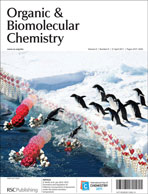The mechanisms of gold(III)-catalyzed synthesis of highly substituted furansvia [3,3]-sigmatropic rearrangements and/or [1,2]-acyloxy migration based on propargyl ketones have been investigated using density functional theory calculations at BHandHLYP/6-31G(d,p) (SDD for Au) level of theory. Solvent effects on these reactions were explored using calculations that included a polarizable continuum model (PCM) for the solvent (toluene). Two plausible pathways that lead to the formation of Au(III) vinyl carbenoid and an allenyl structure through [3,3]-sigmatropic rearrangements, [1,2]-acyloxy migration viaoxirenium and dioxolenylium were performed. Our calculated results suggested: (1) the major pathway of the cycle causes an initial Rautenstrauch-type [1,2]-migration viaoxirenium to form an Au(III) vinyl carbenoid. Subsequent cycloisomerization of this intermediate then provides the corresponding furan whether for the methyl-substituted propargylic acetates or the phenyl-substituted propargylic acetates; (2) for the methyl-substituted propargylic acetates, the formation of Au(III) vinyl carbenoid structures was the rate-determining step. However, intramolecular nucleophilic attack and subsequent cycloisomerization to give the final product was rate-determining for the phenyl-substituted propargylic acetates. The computational results are consistent with the experimental observations of Gevorgyan, et al. for gold(III)-catalyzed synthesis of highly substituted furans based on propargyl ketones.
![Graphical abstract: A DFT study on the mechanism of gold(iii)-catalyzed synthesis of highly substituted furansvia [3, 3]-sigmatropic rearrangements and/or [1, 2]-acyloxy migration based on propargyl ketones](/en/Image/Get?imageInfo.ImageType=GA&imageInfo.ImageIdentifier.ManuscriptID=C0OB01098G&imageInfo.ImageIdentifier.Year=2011)
You have access to this article
 Please wait while we load your content...
Something went wrong. Try again?
Please wait while we load your content...
Something went wrong. Try again?
![Graphical abstract: A DFT study on the mechanism of gold(iii)-catalyzed synthesis of highly substituted furansvia [3, 3]-sigmatropic rearrangements and/or [1, 2]-acyloxy migration based on propargyl ketones](/en/Image/Get?imageInfo.ImageType=GA&imageInfo.ImageIdentifier.ManuscriptID=C0OB01098G&imageInfo.ImageIdentifier.Year=2011)

 Please wait while we load your content...
Please wait while we load your content...